Regenerative Food Systems to Restore Urban-Rural Relationships: Insights from the Concepción Metropolitan Area Foodshed (Chile)
Abstract
1. Introduction
2. Description of the Case
2.1. Domestic Context
2.2. Local Food Systems in the Concepción Metropolitan Area
3. Materials and Methods
3.1. Methodological Framework
3.2. Determining the Foodshed Indicators
- Intensity: This indicator considers the strength of urban-rural relationships between the source of supply and the destination. Each supplier municipality shows in the foodshed indicator map, the degree of intensity of its relationship with the LFS’ urban side: very low, low, medium, high, and very high. This indicator looks to reveal the intensity foodshed scale of each system. For practical purposes, intensity corresponds to the number of foodstuffs that each municipality supplies to ULFS and PLFS.
- Variety: This indicator considers the variety that the source of supply is providing to the LFS’ urban side. Each supplier municipality shows in the foodshed indicator map, the degree of variety its production has: very low, low, medium, high, and very high. This indicator considers the variety foodshed scale of each system. For practical purposes, variety is the number of vegetable and fruit varieties that each municipality supplies to ULFS and PLFS.
- Freshness: This indicator gives insight into the localness of fresh food that the source of supply is providing to the LFS’ urban side. Each supplier municipality shows in the foodshed indicator map, the percentage of fresh food provided versus the total number of foodstuffs provided (intensity). This indicator looks to show the fresh foodshed scale of each system. For practical purposes, the freshness corresponds to the percentage of vegetables and fruits versus processed food that each municipality supplies to ULFS and PLFS.
3.3. Analysing the Regenerative Features
- Diversity is applied to the spatial analysis of production and accessibility to food diversification within the foodshed of each LFS. The more diverse both rural production and urban accessibility to food spaces are in intensity, variety, and freshness, and the more diverse there are in their rural-urban linkages, the more regenerative potential the LFS have. Diversity requires a cross-sectional analysis of the three foodshed indicators: intensity, variety, and freshness (see Figure 3).
- Flexibility is applied to the spatial analysis of productive diversity of each LFS to geographical and climatic conditions. This implies analysing how foodshed indicators adapt to seasonality, where the more flexible the productive diversity to seasons is, the more regenerative potential the LFS has. Flexibility requires a cross-sectional analysis of the indicators in both seasons: summer and winter (see Figure 3).
- Self-reliance is applied to analyzing the spatial regenerative complementarity of both PLFS and ULFS foodsheds. This analysis was done with the aim of understanding whether both systems together could comprise a stronger urban-metropolitan local and alternative food system, with a higher regenerative potential than each LFS separately. The analysis will compare the geographical foodshed, the diversity along with the flexible regenerative features. The more complementary both LFS are, the more regenerative potential the urban-metropolitan local and alternative food systems, and their supply rural-urban linkages, have. Self-reliance requires a cross-sectional analysis of the indicators in both LFS: ULFS and PLFS (see Figure 3).
4. Results
4.1. Geographical Foodshed
4.2. ULFS and PLFS Foodshed Indicators
4.2.1. Intensity Foodshed Indicator
4.2.2. Variety of Foodstuffs Foodshed Indicator
4.2.3. Freshness Foodshed Indicator
4.3. Regenerative Features of ULFS and PLFS
4.3.1. Diversity
4.3.2. Flexibility
4.3.3. Self-reliance
5. Discussions
5.1. Local Scale for the Local Food Systems
5.2. Regenerative Food System to Restore Rural-Urban Relationships
6. Conclusions
Author Contributions
Funding
Acknowledgments
Conflicts of Interest
References
- Kennedy, C.; Cuddihy, J.; Engel-Yan, J. The changing metabolism of cities. J. Ind. Ecol. 2007, 11, 43–59. [Google Scholar] [CrossRef]
- Torreggiani, D.; Dall’Ara, E.; Tassinari, P. The urban nature of agriculture: Bidirectional trends between city and countryside. Cities 2012, 29, 412–416. [Google Scholar] [CrossRef]
- Soja, E. Postmetropolis: Critical Studies of Cities and Regions; Blackwell Publishing: Los Angeles, CA, USA, 2000. [Google Scholar]
- Jacobs, J. The Death and Life of Great American Cities; Random House: New York, NY, USA, 1961; ISBN 978-0679741954. [Google Scholar]
- Mumford, L. The City in History: Its Origins, Its Transformations and Its Prospects; Harcourt, Brace, and World: New York, NY, USA, 1961; ISBN 978-0156180351. [Google Scholar]
- Wiskerke, J.S.C. On places lost and places regained: Reflections on the alternative food geography and sustainable regional development. Int. Plan. Stud. 2009, 14, 369–387. [Google Scholar] [CrossRef]
- Curran-Cournane, F.; Cain, T.; Greenhalgh, S.; Samarsinghe, O. Attitudes of a farming community towards urban growth and rural fragmentation—An Auckland case study. Land Use Policy 2016, 58, 241–250. [Google Scholar] [CrossRef]
- Delgado, M. El sistema agroalimentario globalizado: Imperios alimentarios y degradación social y ecológica. Econ. Crit. 2010, 10, 32–61. [Google Scholar]
- Butt, A. Exploring Peri-urbanisation and agricultural systems in the Melbourne region. Geogr. Res. 2013, 51, 204–218. [Google Scholar] [CrossRef]
- Piorr, A. (Ed.) Peri-Urbanisation in Europe: Towards European Policies to Sustain URBAN-RURAL Futures; Forest & Landscape, University of Copenhagen: Frederiksberg, Copenhagen, Denmark, 2011; ISBN 9788779035348 8779035345. [Google Scholar]
- Maturana, F. ¿Ausencia de planificación urbana en Chile? Algunas reflexiones. Cybergeo Eur. J. Geogr. 2017, 43. Available online: http://journals.openedition.org/cybergeo/28064 (accessed on 17 December 2018).
- Canales, A.; Canales, M. De la metropolización a las agrópolis. El nuevo poblamiento urbano en el Chile actual. Polis 2013, 12, 31–56. [Google Scholar] [CrossRef]
- Dockemdorff, E.; Rodríguez, A.; Winchester, L. Santiago de Chile: Metropolization, globalization and inequity. Environ. Urban 2000, 12, 171–183. [Google Scholar] [CrossRef]
- Steel, C. Hungry City. How Food Shapes Our Lives; Chatto & Windus, Vintage: London, UK, 2008; ISBN 978-0701180379. [Google Scholar]
- Bryant, C.R.; Johnston, T.R.R. Agriculture in the City’s Countryside; University of Toronto: Toronto, ON, Canada, 1992; ISBN 1-85293-027-6. [Google Scholar]
- Oosterveer, P.; Sonnenfeld, D.A. Food, Globalization and Sustainability; Routledge: New York, NY, USA, 2012; ISBN 978-1849712613. [Google Scholar]
- Sundkvist, Å.; Milestad, R.; Jansson, A. On the importance of tightening feedback loops for sustainable development of food systems. Food Policy 2005, 30, 224–239. [Google Scholar] [CrossRef]
- Tsuchiya, K.; Hara, Y.; Thaitakoo, D. Linking food and land systems for sustainable peri-urban agriculture in Bangkok metropolitan region. Landsc. Urban Plan. 2015, 143, 192–204. [Google Scholar] [CrossRef]
- Knight, L.; Riggs, W. Nourishing urbanism: A case of a new urban paradigm. Int. J. Agric. Sustain. 2010, 8, 116–126. [Google Scholar] [CrossRef]
- Tedesco, C.; Petir, C.; Billen, G.; Garnier, J.; Personne, E. Potential for recoupling production and consumption in peri-urban territories: The case-study of the Saclay plateau near Paris, France. Food Policy 2017, 69, 35–45. [Google Scholar] [CrossRef]
- Fonte, M. Knowledge, food and place. A way of producing, a way of knowing. Sociol. Rural. 2008, 48, 200–222. [Google Scholar] [CrossRef]
- Breitbach, C. The geographies of a more just food system: Building landscapes for social reproduction. Landsc. Res. 2008, 32, 533–557. [Google Scholar] [CrossRef]
- McKenzie, F.H.; Stehlik, D. Futures for the Wheatbelt—Is 2030 already here? Aust. J. Agric. Res. 2005, 56, 537–551. [Google Scholar] [CrossRef]
- Dubbeling, M.; Carey, J.; Hochberg, K. The Role of Private Sector in City Regions Food Systems. Analysis Report; RUAF Foundation: Leusden, The Netherlands, 2016. [Google Scholar]
- Feagan, R. The place of food: Mapping out the ’local’ in local food systems. Prog. Hum. Geogr. 2007, 31, 23–42. [Google Scholar] [CrossRef]
- Jennings, S.; Cottee, J.; Curtis, T.; Miller, S. Food in an Urbanized World. The Role of City Region Food Systems in Resilience and Sustainable Development; 3Keel and Prince of Wales’s International Sustainability Unit: London, UK, 2015. [Google Scholar]
- Brunori, G.; Galli, F.; Barjolle, D.; Van Broekhuizen, R.; Colombo, L.; Giampietro, M.; Kirwan, J.; Lang, T.; Mathijs, E.; Maye, D.; et al. Are local food chains more sustainable than food chains? Considerations for assessment. Sustainability 2016, 8, 449. [Google Scholar] [CrossRef]
- Paül, V.; McKenzie, F. Peri-urban farmland conservation and development of alternative food networks: Insights from a case-study area in metropolitan Barcelona (Catalonia, Spain). Land Use Policy 2013, 30, 94–105. [Google Scholar] [CrossRef]
- Martínez, S.; Hand, M.; Da Pra, M.; Pollack, S.; Ralston, K.; Smith, T.; Vogel, S.; Clark, S.; Lohr, L.; Low, S.; et al. Local Food Systems. Concepts, Impacts and Issues; Economic Research Report Number 97; United States Department of Agriculture: Washington, DC, USA, 2010.
- Hinrichs, C. Fixing food with ideas of “local” and “place”. J. Environ. Stud. Sci. 2016, 6, 759–764. [Google Scholar] [CrossRef]
- Eriksen, S. Defining local food: Constructing a new taxonomy—Three domains of proximity. Acta Agric. Scand. B-S P. 2013, 63, 47–55. [Google Scholar] [CrossRef]
- Duarte, B. Regenerative development—Building evolutive capacity for healthy living systems. Int. J. Des. Nat. Ecodyn. 2018, 13, 315–323. [Google Scholar] [CrossRef]
- Zazo, A.; Troncoso, I. Outlining the alternativeness of urban and peasant food networks in the global south. A case study in the concepción metropolitan area (Chile). In Infinite Rural Systems in a Finite Planet: Bridging Gaps towards Sustainability; Paül, V., Lois, R., Trillo, J.M., McKenzie, F., Eds.; Universidad de Santiago de Compostela Publicaciones: Santiago de Compostela, Spain, 2018; pp. 67–76. ISBN 978-84-16954-89-6. [Google Scholar]
- Knieling, J.; Jacuniak-Suda, M.; Obersteg, A. Urban-rural partnerships and governance of peri-urban areas in a European perspective. Towards regenerative regions. In Peri-Urban Areas and Food-Energy-Water Nexus; Colucci, A., Magoni, M., Menoni, S., Eds.; Springer: Cham, Switzerland, 2017. [Google Scholar] [CrossRef]
- Proctor, F.; Berdegué, J. Food Systems at the Rural-Urban Interface; Working Paper Series Nº194; RIMISP: Santiago, Chile, 2016. [Google Scholar]
- Cid, B.; Latta, A. Agro-ecology and food sovereignty movements in Chile: Sociospatial practices for alternative peasant futures. Ann. Assoc. Am. Geogr. 2015, 105, 397–406. [Google Scholar] [CrossRef]
- Moreira-Muñoz, A.; Leguía, M.; Sabaini, C. Ambientes de montaña en transición: Hacia un Sistema sustentable de alimentación en la Región de Valparaíso, Chile. In Die Welt Verstehen—Eine Geographische Herausforderung. Eine Festschrift der Geographie Innsbruck für Axel Borsdorf; Innsbrucker Studienkreis für Geographie: Innsbruck, Austria, 2016; pp. 235–249. ISBN 978-3-901182-43-3. [Google Scholar]
- Freudenberger, C. Agricultural agenda for the twenty-first century. Pro Rege 1988, 16, 15–21. Available online: http://digitalcollections.dordt.edu/pro_rege/vol16/iss4/3 (accessed on 30 March 2019).
- Du Plessis, C. Towards a regenerative paradigm for the built environment. Build. Res. Inf. 2012, 40, 7–22. [Google Scholar] [CrossRef]
- Holling, C.S.; Gunderson, L.H. Resilience and adaptive cycles. In Panarchy. Understanding Transformations in Human and Natural System; Gunderson, L.H., Holling, C.S., Eds.; Island Press: Washington, DC, USA, 2002; pp. 25–62. ISBN 9781559638579. [Google Scholar]
- Dahlberg, K. Regenerative food systems. In Management of Agricultural, Forestry and Fisheries Enterprises. Encyclopedia of Life Support Systems (EOLSS); Hudson, R., Ed.; UNESCO, Eolss Publishers: Oxford, UK, 2006; Volume 2, pp. 172–189. ISBN 978-1-84826-200-3. [Google Scholar]
- Dahlberg, K.A. Regenerative food systems: Broadening the scope and agenda of sustainability. In Food for the Future; Allen, P., Ed.; John Wiley and Sons: New York, NY, USA, 1993; pp. 75–102. ISBN 978-0471580829. [Google Scholar]
- Dahlberg, K. A transition from agriculture to regenerative food systems. Futures 1994, 26, 170–179. [Google Scholar] [CrossRef]
- Hedden, W. How Great Cities are Fed; D.C. Health and Company: New York, NY, USA, 1929. [Google Scholar]
- Getz, A. Urban foodsheds. Permac. Act. 1991, 24, 26–27. [Google Scholar]
- Stagl, S. Local organic food markets: Potentials and limitations for contributing to sustainable development. Empirica 2002, 29, 145–162. [Google Scholar] [CrossRef]
- Kloppenburg, J.; Hendrickson, J.; Stevenson, S.T. Coming into the foodshed. Agric. Hum. Values 1996, 13, 33–42. [Google Scholar] [CrossRef]
- Peters, C.; Bills, N.; Lembo, A.; Wilkins, J.; Fick, G. Foodshed analysis and its relevance to sustainability. Renew. Agric. Food Syst. 2009, 24, 72–84. [Google Scholar] [CrossRef]
- Pretty, J. Towards sustainable food and farming systems in industrialized countries. IJARGE 2000, 1, 77–94. [Google Scholar] [CrossRef]
- Álvarez, L. Alimentación de proximidad. Territorializaciones posibles de una alianza entre los mercados municipales y el territorio agrario periurbano de Madrid. Territ. Form. 2017, 12, 3–23. [Google Scholar] [CrossRef][Green Version]
- Saavedra, A.; Domingos, T.; Raposo, M.; De Melo-Abreu, J.; Palma, J. Mapping the Lisbon potential foodshed in Ribatejo e Oeste: A suitability and yield model for assessing the potential for localized food production. Sustainability 2017, 9, 2003. [Google Scholar] [CrossRef]
- Zasada, I.; Schmutz, U.; Wascher, D.; Kneafsey, M.; Corsi, S.; Mazzocchi, C.; Monaco, F.; Boyce, P.; Doernberg, A.; Sali, G.; et al. Food beyond the city—Analysing foodsheds and self-sufficiency for different food system scenarios in European metropolitan regions. City Cult. Soc. 2017, 16, 25–35. [Google Scholar] [CrossRef]
- Galzki, J.C.; Mulla, D.J.; Meier, E. Mapping potential foodsheds using regionalized consumer expenditure data for Southeastern Minnesota. J. Agric. Food Syst. Community Dev. 2017, 7, 181–196. [Google Scholar] [CrossRef]
- Galzki, J.C.; Mulla, D.J.; Peters, C. Mapping the potential of local food capacity in Southeastern Minnesota. Renew. Agric. Food Syst. 2014, 30, 364–372. [Google Scholar] [CrossRef]
- Sali, G.; Corsi, S.; Monaco, F.; Mazzocchi, C.; Glavan, M.; Pintar, M. Urban-rural relationships in feeding metropolis: A case study in Ljubljana metropolitan area. Adv. Eng. Forum 2014, 11, 259–264. [Google Scholar] [CrossRef]
- Giombolini, K.; Chambers, K.; Schlegel, S.; Dunne, J. Testing the local reality: Does the Willamette Valley growing region produce enough to meet the needs of the local population? A comparison of agriculture production and recommended dietary requirements. Agric. Hum. Values 2011, 28, 247–262. [Google Scholar] [CrossRef]
- Hu, G.; Wang, L.; Arendt, S.; Boeckenstedt, R. An optimization approach to assessing the self-sustainability potential of food demand in the Midwestern United States. J. Agric. Food Syst. Community Dev. 2011, 2, 195–207. [Google Scholar] [CrossRef]
- Kremer, P.; DeLiberty, T. Local food practices and growing potential: Mapping the case of Philadelphia. Appl. Geogr. 2011, 31, 1252–1261. [Google Scholar] [CrossRef]
- Peters, C.; Bills, N.; Lembo, A.; Wilkins, J.; Fick, G. Mapping potential foodsheds in New York State: A spatial model for evaluating the capacity to localize food production. Renew. Agric. Food Syst. 2008, 24, 72–84. [Google Scholar] [CrossRef]
- Swiader, M.; Szevranski, S.; Kazak, J. Foodshed as an example of preliminary research for conducting environmental carrying capacity analysis. Sustainability 2018, 10, 882. [Google Scholar] [CrossRef]
- Billen, G.; Barles, S.; Chatzimpiros, P.; Garnier, J. Grain, meat and vegetables to feed Paris: Where did and do they come from? Localising Paris food supply areas from the eighteenth to the twenty-first century. Reg. Environ. Chang. 2012, 12, 325–335. [Google Scholar] [CrossRef]
- Billen, G.; Barles, S.; Garnier, J.; Rouillard, J.; Benoit, P. The food-print of Paris: Long-term reconstruction of the nitrogen flows imported into the city from its rural hinterland. Reg. Environ. Chang. 2009, 9, 13–24. [Google Scholar] [CrossRef]
- Rodríguez, B. Nuestro pan de cada día: Huella ecológica alimentaria de Bogotá. In Anais do X Encontro de Geógrafos da América Latina; Universidade de São Paulo: São Paulo, Brazil, 2005. [Google Scholar]
- Henríquez, C.; Mallea, C.; Henríquez-Dole, L.; Samaniego, H. Dispersión y escalamiento urbano en el sistema de ciudades chileno urban sprawl and scaling in the Chilean cities system. Investig. Geogr. Chile 2017, 54, 5–22. [Google Scholar] [CrossRef]
- Rojas, C.; Sepúlveda-Züñiga, W.; Barbosa, O.; Rojas, O.; Martínez, C. Patrones de urbanización en la biodiversidad de humedales urbanos en Concepción metropolitano. Rev. Geogr. Norte Gd. 2015, 61, 181–204. [Google Scholar] [CrossRef]
- ODEPA. Impacto de la Expansión Urbana Sobre el Sector Agrícola en la Región Metropolitana de Santiago; Oficina de Estudios y Políticas Agrarias, Ministerio de Agricultura: Santiago de Chile, Chile, 2012. [Google Scholar]
- Bengoa, J. La vía chilena al “sobre” capitalismo agrario. An. Univ. Chile 2017, 12, 73–93. [Google Scholar] [CrossRef][Green Version]
- Servicio Nacional de Aduanas. Registros de Importación y Exportación; Ministerio de Hacienda: Santiago de Chile, Chile, 2016. [Google Scholar]
- MINSAL. Marco Conceptual Sobre los Factores Condicionantes de los Ambientes Alimentarios en Chile; Ministerio de Salud, Facultad de Medicina Universidad de Chile: Santiago de Chile, Chile, 2016. [Google Scholar]
- Panez-Pinto, A.; Mansilla-Quiñones, P.; Moreira-Muñoz, A. Agua, tierra y fractura sociometabólica del agronegocio. Actividad fruitcola en Petorca, Chile. Bitácora 2018, 28, 153–160. [Google Scholar] [CrossRef]
- Sarricolea, P.; Herrera-Ossandon, M.; Meseguer-Ruiz, Ó. Climatic regionalization of continental Chile. J. Maps 2017, 13, 66–73. [Google Scholar] [CrossRef]
- Aguayo, M.; Pauchard, A.; Azócar, G.; Parra, O. Cambio del uso del suelo en el centro sur de Chile a fines del siglo XX. Entendiendo la dinámica especial y temporal del paisaje. Rev. Chil. Hist. Nat. 2009, 82, 261–374. [Google Scholar] [CrossRef]
- Cid, B. Movimientos agroecológico y neo campesino: Respuestas postmodernas a la clásica cuestión agraria. Agroalimentaria 2014, 20, 65–78. [Google Scholar]
- Cid, B. Agroecología y agricultura orgánica en Chile: Entre convencionalización y ciudadanía ambiental. Agroalimentaria 2011, 17, 15–27. [Google Scholar]
- Rojas, C.; Muñoz, I.; García-López, M. Estructura urbana y policentrismo en el Área Metropolitana de Concepción. Rev. Eure 2009, 35, 47–70. [Google Scholar]
- Aliste, E.; Almendras, A.; Contreras, M. La dinámica del territorio en la conurbación Concepción-Talcahuano: Huellas urbanas para una interpretación de las transformaciones ambientales durante la segunda mitad del siglo XX. Rev. Geogr. Norte Gd. 2012, 52, 5–18. [Google Scholar] [CrossRef]
- SERCOTEC. Catastro Nacional de Ferias Libres; Servicio de Cooperación Técnica, Ministerio de Economía, Fomento y Turismo, Gobierno de Chile: Santiago de Chile, Chile, 2016. [Google Scholar]
- García Ramón, M.D. Valor actual del modelo de Von Thünen y dos comprobaciones empíricas. Rev. Geogr. 1976, 10, 11–33. [Google Scholar]
- Sinclair, R. Von Thünen and urban sprawl. Ann. Assoc. Am. Geogr. 1967, 57, 72–87. [Google Scholar] [CrossRef]
- Chisholm, M. Rural Settlement and Land Use; Hutchinson University Library: London, UK, 1962. [Google Scholar]
- McMichael, P. A food regime genealogy. J. Peasant Stud. 2009, 36, 139–169. [Google Scholar] [CrossRef]
- Gibson-Graham, J.K.; Cameron, J.; Healy, S. Retomemos la Economía. Una Guía Ética Para Transformar Nuestras Comunidades; Editorial Pontificia Universidad Javierana: Bogota, Colombia, 2017; ISBN 9789587810684. [Google Scholar]
- Stöhr, W. Selective self-reliance and endogenous regional development—Preconditions and constraints. Iir Discuss. Pap. 1984, 19, 1–21. [Google Scholar]
- Sonnino, R. Local foodscape: Place and power in the agri-food system. Acta Agr. Scand. B-S P 2013, 63, 2–7. [Google Scholar] [CrossRef]
- Wilhelmina, Q.; Joost, J.; George, E.; Guido, R. Globalization vs. localization: Global food challenges and local solutions. Int. J. Consum. Stud. 2010, 34, 357–366. [Google Scholar] [CrossRef]
- Van der Lans, C.J.M.; Hengsdijk, H.; Elings, A.; Van der Schans, J.W.; Aarnink, A.J.A.; Yao, M. Metropolitan Agriculture. Wuhan and Addis Ababa, Two Developing Metropoles; Report GTB-1072; Wageningen UR Greenhouse Horticulture, Ministry of Economic Affairs, Agriculture and Innovation: Wageningen, The Netherlands, 2011. [Google Scholar]
- Sasaki, Y.; Box, P. Agent-based verification of von Thünen’s location theory. J. Artif. Soc. Soc. Simul. 2003, 6, 1–9. [Google Scholar]
- Kremer, P.; Schreuder, Y. The feasibility of regional food systems in metropolitan areas: An investigation of Philadelphia’s foodshed. J. Agric. Food Syst. Community Dev. 2012, 2, 171–191. [Google Scholar] [CrossRef]
- Wiskerke, J.S.C. Rural sociology in the Netherlands: Past, present and future. Agrarwirtsch. Agrarsoziol. 2004, 2, 39–62. [Google Scholar]
- Tendall, D.M.; Joerin, J.; Kopainsky, B.; Edwards, P.; Shreck, A.; Le, Q.B.; Kruetli, P.; Grant, M.; Six, J. Food system resilience: Defining the concept. Glob. Food Secur. 2015, 6, 17–23. [Google Scholar] [CrossRef]
- Quinlan, A.; Berbés-Blázquez, M.; Haider, J.; Peterson, G. Measuring and assessing resilience: Broadening understanding through multiple disciplinary perspectives. J. Appl. Ecol. 2016, 53, 677–687. [Google Scholar] [CrossRef]
- Feenstra, G. Local food systems and sustainable communities. Am. J. Altern. Agric. 1997, 12, 28–36. [Google Scholar] [CrossRef]
- Duram, L.; Oberholtzer, L. A geographic approach to place and natural resource use in local food systems. Renew. Agric. Food Syst. 2010, 25, 99–108. [Google Scholar] [CrossRef]
- Paredes, M.; Sherwood, S.; Arce, A. La contingencia del cambio social en la agricultura y la alimentación en América Latina. Íconos 2016, 54, 11–25. [Google Scholar] [CrossRef][Green Version]
- Marchant, C.; Fuentes, N. Agricultura Familiar (AF) en América Latina: Desafíos a enfrentar en la era del cambio ambiental global. In Die Welt Verstehen—Eine Geographische Herausforderung. Eine Festschrift der Geographie Innsbruck für Axel Borsdorf; Innsbrucker Studienkreis für Geographie: Innsbruck, Austria, 2016; pp. 221–234. ISBN 978-3-901182-43-3. [Google Scholar]
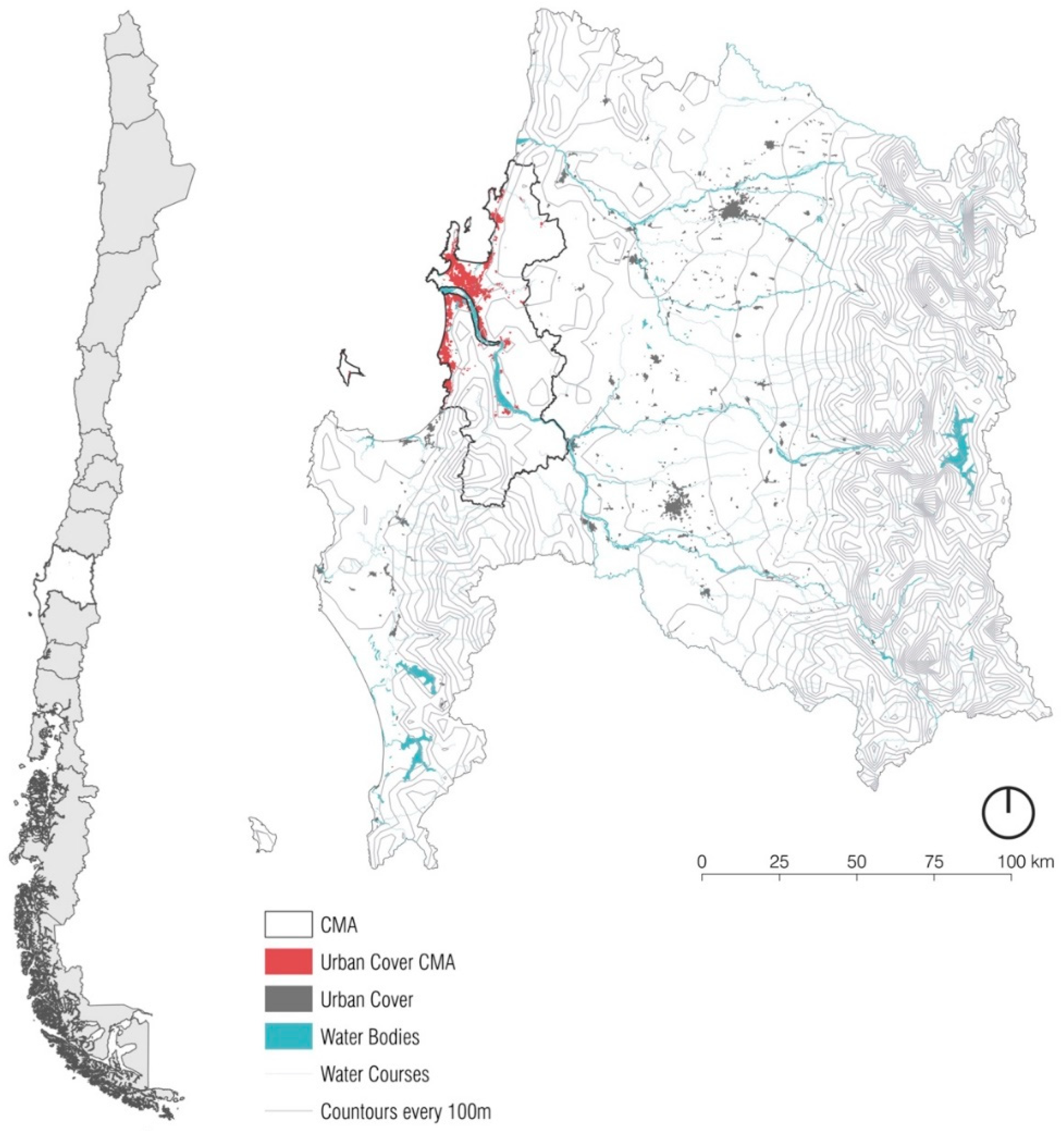
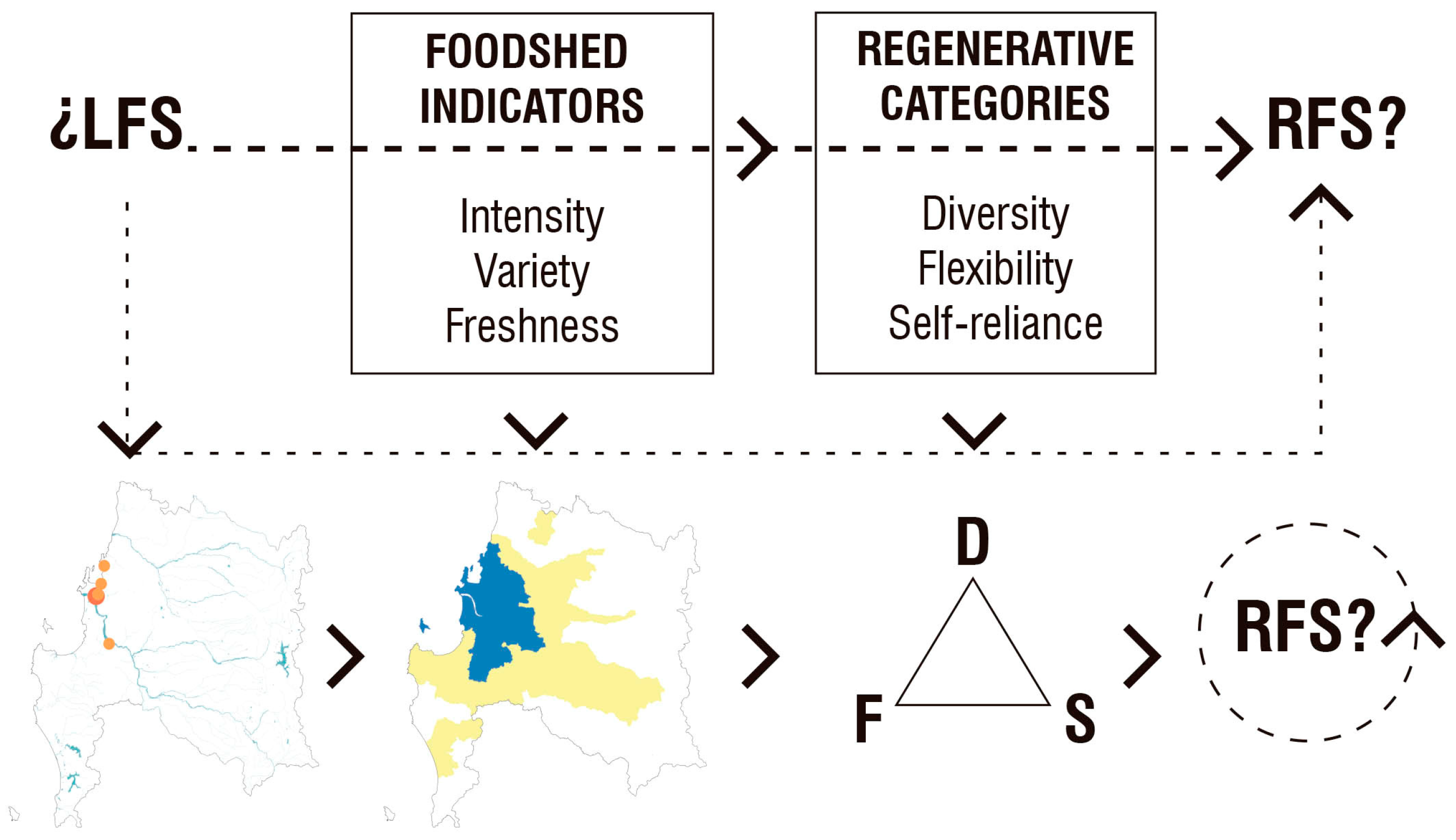

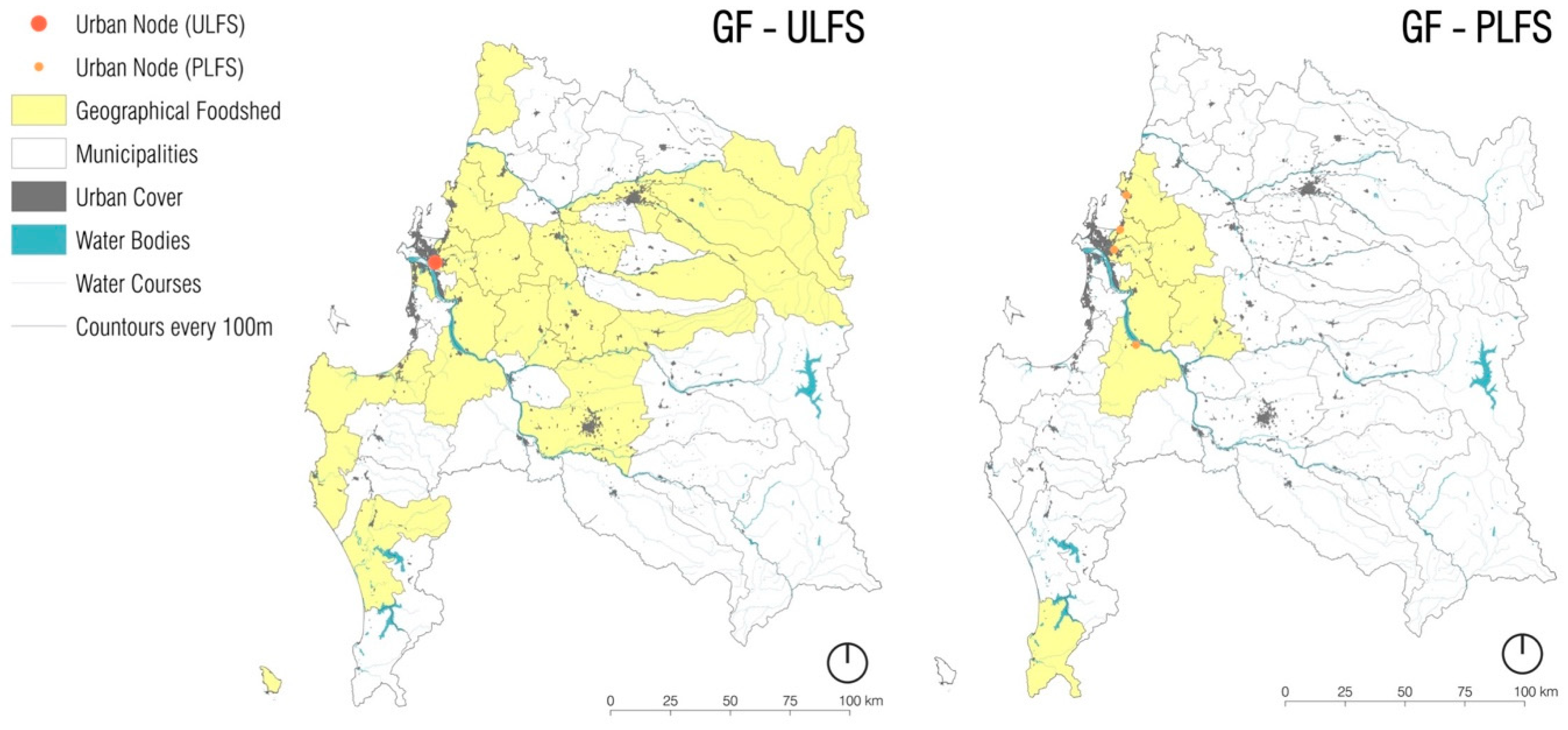
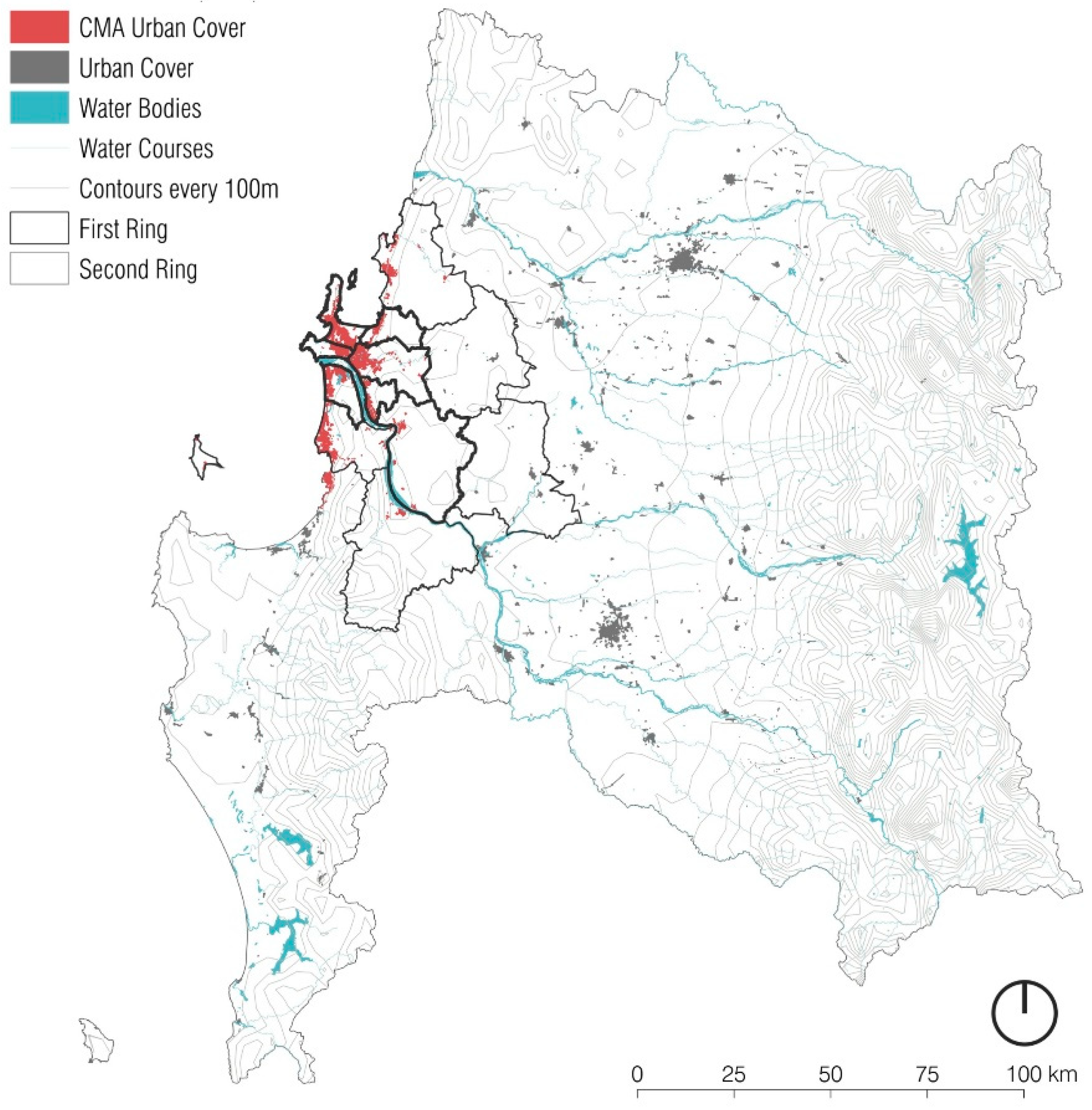
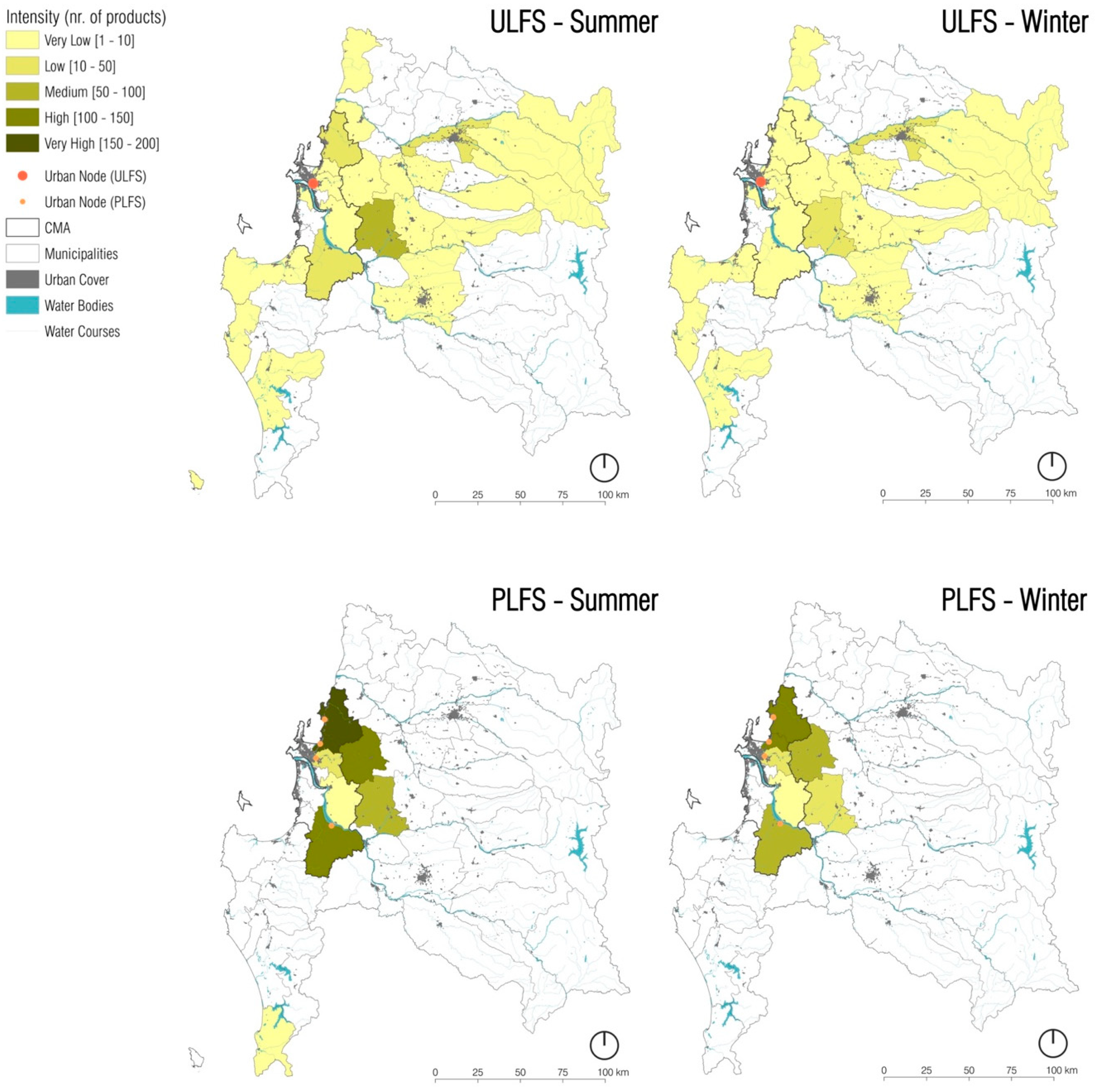
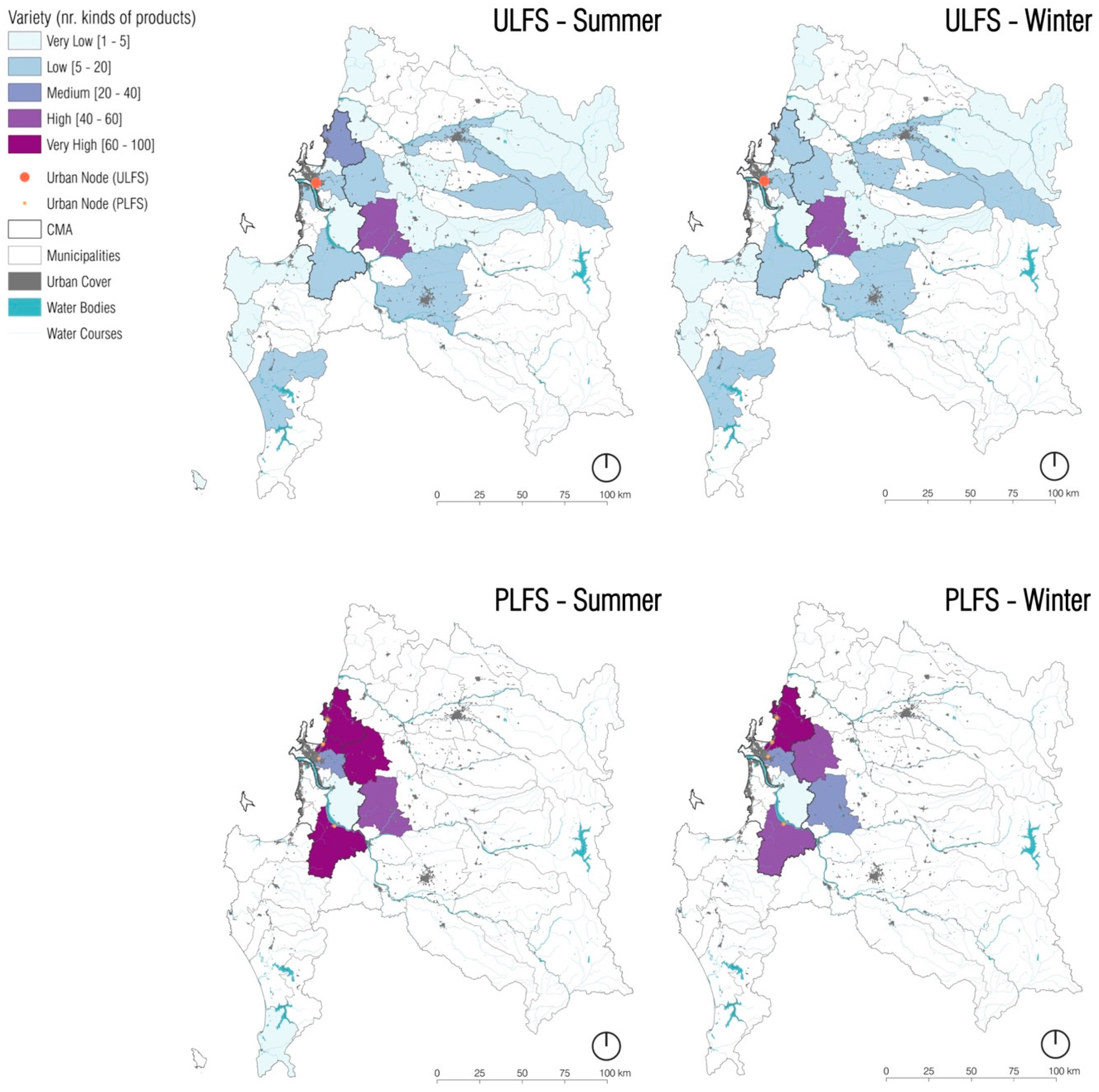

| LFS | ULFS | PLFS | ||
|---|---|---|---|---|
| Season | Summer | Winter | Summer | Winter |
| Urban points | 7 | 7 | 46 | 46 |
| Urban nodes | 0 | 0 | 4 | 4 |
| Supplier municipalities | 23 | 23 | 8 | 8 |
| Intensity | 216 | 166 | 736 | 428 |
| Variety | 180 | 152 | 208 | 157 |
| Freshness | 39.8% | 27.7% | 60.1% | 46.7% |
| ULFS | PLFS | |
|---|---|---|
| Geographical foodshed | Wide Diverse geographical and climatic characteristics | Compact Specific geographical and climatic characteristics |
| Diversity 1. Diversification of production spaces | High productive diversity Specialized foodshed Processed food oriented | Low productive diversity Diverse foodshed Fresh food oriented |
| Diversity 2. Diversification of food access spaces | Concentrated urban point Open to heterogeneous citizens | Dispersed urban nodes Citizens segmented by location |
| Flexibility | Keeps the level of production all-year-round | |
© 2019 by the authors. Licensee MDPI, Basel, Switzerland. This article is an open access article distributed under the terms and conditions of the Creative Commons Attribution (CC BY) license (http://creativecommons.org/licenses/by/4.0/).
Share and Cite
Zazo-Moratalla, A.; Troncoso-González, I.; Moreira-Muñoz, A. Regenerative Food Systems to Restore Urban-Rural Relationships: Insights from the Concepción Metropolitan Area Foodshed (Chile). Sustainability 2019, 11, 2892. https://doi.org/10.3390/su11102892
Zazo-Moratalla A, Troncoso-González I, Moreira-Muñoz A. Regenerative Food Systems to Restore Urban-Rural Relationships: Insights from the Concepción Metropolitan Area Foodshed (Chile). Sustainability. 2019; 11(10):2892. https://doi.org/10.3390/su11102892
Chicago/Turabian StyleZazo-Moratalla, Ana, Isidora Troncoso-González, and Andrés Moreira-Muñoz. 2019. "Regenerative Food Systems to Restore Urban-Rural Relationships: Insights from the Concepción Metropolitan Area Foodshed (Chile)" Sustainability 11, no. 10: 2892. https://doi.org/10.3390/su11102892
APA StyleZazo-Moratalla, A., Troncoso-González, I., & Moreira-Muñoz, A. (2019). Regenerative Food Systems to Restore Urban-Rural Relationships: Insights from the Concepción Metropolitan Area Foodshed (Chile). Sustainability, 11(10), 2892. https://doi.org/10.3390/su11102892





